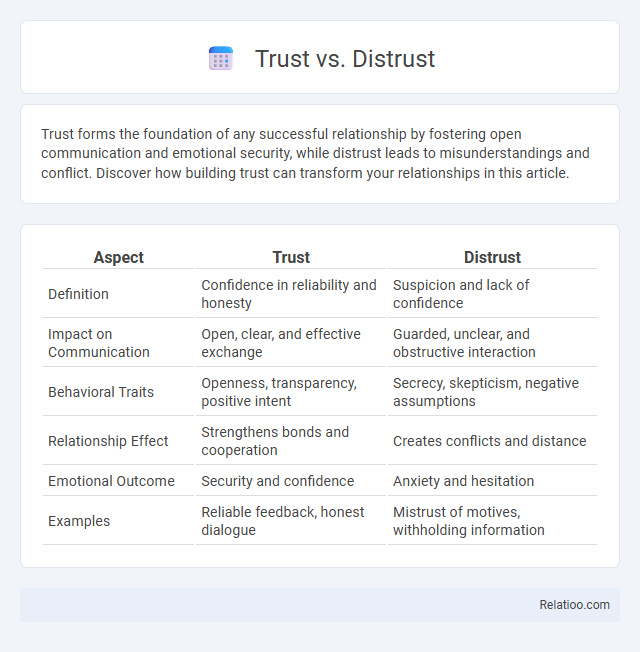Trust forms the foundation of any successful relationship by fostering open communication and emotional security, while distrust leads to misunderstandings and conflict. Discover how building trust can transform your relationships in this article.
Table of Comparison
| Aspect | Trust | Distrust |
|---|---|---|
| Definition | Confidence in reliability and honesty | Suspicion and lack of confidence |
| Impact on Communication | Open, clear, and effective exchange | Guarded, unclear, and obstructive interaction |
| Behavioral Traits | Openness, transparency, positive intent | Secrecy, skepticism, negative assumptions |
| Relationship Effect | Strengthens bonds and cooperation | Creates conflicts and distance |
| Emotional Outcome | Security and confidence | Anxiety and hesitation |
| Examples | Reliable feedback, honest dialogue | Mistrust of motives, withholding information |
Understanding the Concepts: Trust vs Distrust
Trust forms the foundation of reliable relationships by fostering confidence and positive expectations between parties, while distrust generates skepticism and caution, often leading to strained interactions. Understanding the nuanced differences between trust and distrust helps you navigate social dynamics effectively, promoting healthier communication and decision-making. Recognizing the signs and causes of distrust can empower you to rebuild trust and strengthen connections over time.
Psychological Foundations of Trust and Distrust
Trust and distrust originate from different psychological foundations involving cognitive, emotional, and social processes. Trust is built through repeated positive experiences, perceived reliability, and the expectation of benevolent intentions, activating brain regions associated with reward and social bonding. Distrust arises from threat detection, uncertainty, and past negative experiences, engaging neural circuits related to fear and vigilance, which protect individuals from potential harm.
The Role of Trust in Personal Relationships
Trust is the foundation of personal relationships, fostering emotional security and open communication between individuals. Distrust erodes connection, leading to misunderstandings and conflict, while rebuilding trust requires consistent honesty, empathy, and reliability. High trust levels correlate with increased relationship satisfaction and resilience in overcoming challenges.
The Impact of Distrust on Communication
Distrust significantly hampers effective communication by creating barriers to openness and honesty, leading individuals to withhold information or misinterpret messages. This erosion of mutual trust fosters suspicion and defensive behaviors, which obstruct collaborative problem-solving and meaningful dialogue. Consequently, the overall quality of relationships and organizational performance deteriorates as communication breakdowns become more frequent and severe.
Trust vs Distrust in the Workplace
Trust vs. distrust in the workplace critically influences team collaboration, employee engagement, and organizational productivity. High levels of trust foster open communication, innovation, and job satisfaction, while distrust leads to conflict, low morale, and reduced efficiency. Building trust requires consistent transparency, reliability, and support from leadership to cultivate a positive work environment.
Building and Maintaining Trust
Building and maintaining trust requires consistent transparency, reliable communication, and demonstrated integrity over time. Trust develops when individuals or organizations deliver on promises and show accountability, reducing uncertainty and fostering strong relationships. Distrust often emerges from inconsistent behavior, lack of openness, or perceived deception, which can erode confidence and hinder collaboration.
Factors Leading to Distrust
Factors leading to distrust include inconsistent communication, lack of transparency, and previous breaches of confidence that damage Your perception of reliability. When promises are unfulfilled and actions contradict words, trust diminishes, resulting in skepticism and emotional distance. Emotional experiences, such as betrayal or neglect, intensify feelings of distrust, undermining relationships and collaboration.
Social and Cultural Influences on Trust
Social and cultural influences significantly shape how trust is formed and maintained, as individuals in collectivist societies often prioritize communal relationships and group harmony, fostering higher baseline trust within in-groups. In contrast, individualistic cultures may emphasize personal autonomy and skepticism, leading to more conditional trust based on demonstrated reliability. Cross-cultural variations in communication styles, social norms, and historical contexts further impact the development and erosion of trust, creating complex dynamics between trust, distrust, and re-establishment of trust in interpersonal and organizational interactions.
Rebuilding Trust After It’s Broken
Rebuilding trust after it's broken requires consistent transparency, open communication, and accountability to restore confidence in relationships. Your willingness to acknowledge mistakes and demonstrate genuine change strengthens trustworthiness and fosters emotional security. Establishing clear boundaries and showing patience throughout the healing process accelerates the restoration of trust over time.
Trust vs Distrust: Long-term Consequences
Trust versus distrust fundamentally shapes your long-term relationships and organizational culture, influencing collaboration, communication, and overall stability. High levels of trust foster commitment, cooperation, and resilience, while pervasive distrust leads to conflict, decreased productivity, and heightened turnover rates. Building consistent trust mitigates risks of misunderstandings and strengthens emotional connections, crucial for sustainable social and professional success.

Infographic: Trust vs Distrust
 relatioo.com
relatioo.com